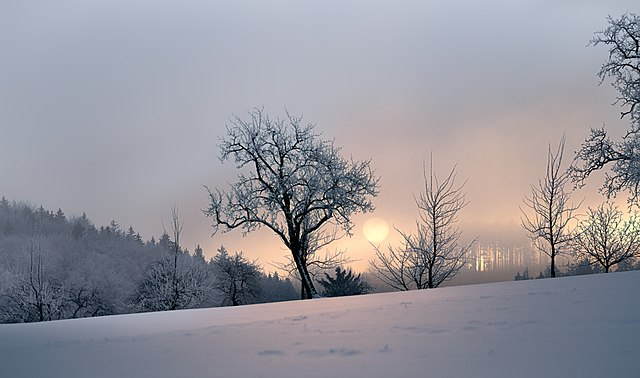
The Art Of February
February, with its short days, freezing weather, pale sunlight, and few flowers, might seem an unlikely month to inspire visual artists. But that’s not actually the case; over the centuries, artists have found much in February to stimulate and delight them. Here are two famous images of this month which capture both its bleakness and austere beauty.
February In Miniature
Firstly, here’s ‘February’ from Très Riche Heures. Très Riche Heures is a Book of Hours, or devotional book. It was created between 1412 and 1416 by the Limbourg Brothers, a trio of renowned Dutch artists, for a French prince called John, Duke of Berry. The Limbourg Brothers and the Duke all died in 1416, with Très Riche Heures being left unfinished. Nonetheless, the unfinished book is lavishly illustrated with numerous miniature images, many marginal decorations, beautiful calligraphy, and an illustration for each month. ‘February’ is a depiction of a winter agricultural scene. There’s heavy snow on the ground, and more in the grey sky. Peasants are engaged in homely tasks: chopping wood, driving a donkey laden with the same, and keeping warm by a fire. The scene shows the importance of animals to this rural economy; as well as the donkey, there are sheep in a pen, wild birds, a dovecote, and a beehive. The Limbourg Brothers’ great skill and meticulous attention to detail make this image stunning. As a portrait of life at this time Très Riche Heures is one of the most valuable books in the world.
You can view ‘February’ here.
Victorian Sentiment
Turning from the fifteenth to the nineteenth century, the next image is February Fill Dyke, a famous Victorian landscape created in 1881 by Benjamin William Leader. It’s another rural scene. The title of this painting makes reference to a traditional country rhyme which describes heavy rain or snow filling up the ditches in winter: ‘February, fill the dyke, with the black or with the white’, in other words, with black rain or white snow.
Appropriately, this painting depicts a winter landscape which is saturated with mud and water. The sun is setting on a chilly winter evening, as two children and a dog head home after a muddy walk. The farmer at the gate and woman collecting firewood appear to be their parents. The human elements of this painting give it a typically Victorian sentimental touch. The scene has a sombre beauty, but its vast, cold sky and waterlogged fields edged with leafless, skeletal trees imply that these wandering children will be glad to return to the warmth and safety of home, where a comforting fire has been lit.
You can view February, Fill Dyke here.
The creators of these two works of art are separated by several centuries, and are from different places, cultures and values. Yet these images are surprisingly similar in their representations of February as a month of not only harsh weather and hard labour, but also of striking contrasts and unexpected beauty. These artists strove to make us look again, and to see February in a new light. During its remaining days, why not take a closer look around you, to discover – and perhaps even to record in your own sketch or painting – your own perceptions of this unique month?
To view more ways in which winter has inspired visual artists, follow this link to an article on the BBC website: ‘How great artists depict winter in ten sublime paintings’.